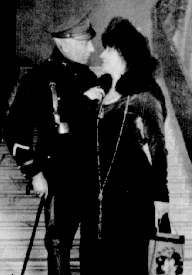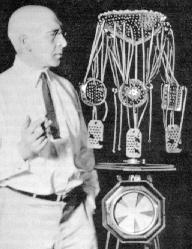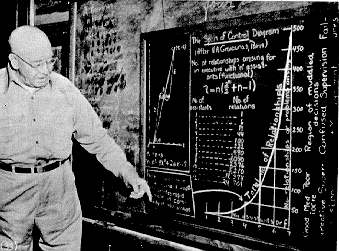

Alfred Korzybski (pronounced "Kahrshibski") was born July 3, 1879, in Warsaw, Poland, to wealthy, aristocratic parents. By his teenage years he could speak and write in four languages -- Polish, Russian, French and German. He managed his father's farm before attending the Polytechnic Institute at Warsaw to study chemical engineering.
At the outbreak of World War I in 1914, Korzybski, age 35, volunteered to join the Second Russian Army, where he served as a battlefield intelligence officer on the eastern front in Poland. Here he experienced the death and destruction of war first hand. He was injured three times during the war: a minor bullet wound to the knee, a hiatal hernia while clearing a cannon from a muddy road and, most severely, a crushed left hip when his horse was shot and fell on him.
In November 1915 he was sent to Canada as a weapons inspector for the Russian Army. Here he began studying English, which became his favorite language and the one in which he would write his major works.
After the United States joined the war in 1917, Korzybski moved to New York to supervise the shipping of war materials to Russia. When the Russian Army and government collapsed later that year, he stayed in the United States to continue war efforts on behalf of the French and Polish armies.
Soon the United States Government hired him to travel the U.S. as a war lecturer to encourage sale of Liberty bonds.
 Shortly after the Armistice, Korzybski met Mira Edgerly (1872-1954), a prominent American portrait painter on ivory. They were married two months later, in January 1919, in the chambers of the United States Supreme Court in Washington, D.C. It was Edgerly's second marriage.
Shortly after the Armistice, Korzybski met Mira Edgerly (1872-1954), a prominent American portrait painter on ivory. They were married two months later, in January 1919, in the chambers of the United States Supreme Court in Washington, D.C. It was Edgerly's second marriage.
His experiences during the war led Korzybski to contemplate the causes of the periodic bloodbaths that afflicted civilization. Eventually this led him to ponder the differences between humans and animals. He observed that animals by nature were mere hunters and gatherers ("space-binders") in their pursuit of food, whereas humans practiced agriculture, reflecting a human capacity to anticipate needs, learn from experiences and readily transmit these experiences as symbols to succeeding generations. He labelled this unique human behavior "time-binding" and noted that the rate of growth of human knowledge resembled a geometric (exponential) progression. Korzybski felt that teaching humans animalistic or mythological theories about themselves helped create and perpetuate such episodes as the recent war.
Korzybski was encouraged to develop and publish his ideas by friends that included biologist Jacques Loeb (1859-1924) and mathematician Cassius Jackson Keyser (1862-1947). With considerable editorial assistance from Keyser, Korzybski published his ideas in 1921 as Manhood of Humanity: The Science and Art of Human Engineering. The first printing of the book sold out in 6 weeks.
Korzybski continued his research into the mechanisms of time-binding, and attempted a synthesis of the sciences from the standpoint of a theory of human evaluation. He included the field of psychiatry in his research, and studied for 2 years with William Alanson White, superintendent of the St. Elizabeth's Hospital in Washington, D.C.
From 1928 until 1933 Korzybski spent most of his time writing what was to become his most famous book, "Time-Binding: The General Theory." At the last moment, however, he changed the name to Science and Sanity: An Introduction to Non-Aristotelian Systems and General Semantics. The new title, Korzybski felt, made clearer the results of his research. Bridges rarely collapse, Korzybski noted, because of the power of scientific methods and mathematical languages that are used to produce them. His book explored means of transferring the predictability of science-mathematical methods to the everyday behavior of ordinary people.
"Science and Sanity" contended that humans progressed ("time-binding") largely as a result of our more flexible nervous systems that were capable of symbolism and abstracting in endless orders. Language allowed us to summarize or generalize our experiences and pass them on to others, saving others from having to make the same mistakes or reinvent what had already been discovered.
This linguistic generalizing ability of humans, Korzybski contended, accounted for our amazing progress over animals, but the misuse of this mechanism accounted for many of our problems as well.
 Just as we need training in how to safely drive a car, Korzybski suggested we needed training in the use of language to prevent misevaluation of non-verbal as well as verbal realities. He formulated his law of non-identity, also called the principle of individuality, which states that no two persons or situations or stages of processes or meanings are the same in ALL details. In emphasizing differences over similarities, Korzybski replaced as fundamental several postulates of Aristotelian logic -- most significantly, the law of identity or "A is A" -- and so Korzybski referred to his system as Non-Aristotelian. This label was not intended to belittle Aristotle, about whom Korzybski often expressed admiration and who was one of the scholars to whom Korzybski dedicated Science and Sanity.
Just as we need training in how to safely drive a car, Korzybski suggested we needed training in the use of language to prevent misevaluation of non-verbal as well as verbal realities. He formulated his law of non-identity, also called the principle of individuality, which states that no two persons or situations or stages of processes or meanings are the same in ALL details. In emphasizing differences over similarities, Korzybski replaced as fundamental several postulates of Aristotelian logic -- most significantly, the law of identity or "A is A" -- and so Korzybski referred to his system as Non-Aristotelian. This label was not intended to belittle Aristotle, about whom Korzybski often expressed admiration and who was one of the scholars to whom Korzybski dedicated Science and Sanity.
Korzybski noted that we have fewer words and ideas than experiences, and this tends to lead to the identification ("confusion") of two or more situations. For example, the word "apple" is commonly applied to millions of different fruit objects, to the 'same' object at different times and contexts, to scientific events on submicroscopic levels within the fruit object, to inedible fruit objects used for decoration, to mental images of these objects, to illustrations like the one on this page, and even to the combined letters a-p-p-l-e.
Korzybski developed a training program to teach people how to see past their local blinders ("neuro-semantic environment") to more factually evaluate the unique characteristics of their daily experiences. His goal was to help people evaluate less by local prejudices and the implications of their everyday language (by intension) and more by the unique facts of a situation (by extension).
Korzybski advocated the application of a few mathematical devices to our daily language, such as indexes (apple1, apple2, apple3 ...) and dates (US1930, US1940 ...) to encourage a more factual orientation among language users. He also encouraged the use of more actional, relational terms. Instead of saying what something "is" we, instead, describe what it does or how it relates to a greater whole. He also developed visual tools to teach humans to differentiate between non-verbal and verbal levels, descriptive and inferential levels, et cetera.
 Korzybski felt that to break away from the limitations of one's daily language we needed new ways of 'thinking.' He advocated 'thinking' on silent levels in terms of visual images, and he developed many visual aids for his theories including the Structural Differential, which in its most detailed form was a '3-dimensional' model of the differences between the orders of abstraction (see photo at left). Differences between the orders of abstraction include differences between verbal and non-verbal levels, between descriptions and inferences, between descriptions(2) about descriptions(1), between inferences(2) from inferences(1), between affect(2) about affect(1), between what we see and the external stimuli themselves, between my abstractions and your abstractions, et cetera.
Korzybski felt that to break away from the limitations of one's daily language we needed new ways of 'thinking.' He advocated 'thinking' on silent levels in terms of visual images, and he developed many visual aids for his theories including the Structural Differential, which in its most detailed form was a '3-dimensional' model of the differences between the orders of abstraction (see photo at left). Differences between the orders of abstraction include differences between verbal and non-verbal levels, between descriptions and inferences, between descriptions(2) about descriptions(1), between inferences(2) from inferences(1), between affect(2) about affect(1), between what we see and the external stimuli themselves, between my abstractions and your abstractions, et cetera.
Korzybski's devices were designed to encourage people to delay their immediate reactions while they searched for the unique characteristics of a situation and alternative interpretations. He was trying to link science-mathematical methods with sanity.

Following publication of his book in October, 1933, Korzybski set out to conduct seminars at schools and colleges throughout the country on his theory of proper human evaluation, which he called General Semantics. In 1938, with financial support from plumbing fixtures heir Cornelius Crane, he founded the Institute of General Semantics near the University of Chicago campus to serve as a training center and to promote research in the new discipline. During World War II he helped S.I. Hayakawa and others establish the International Society for General Semantics, which in 2003 merged with the Institute. His book went through three editions during his lifetime, and he helped organize three congresses that brought together scholars interested in his work.
A housing shortage following World War II forced Korzybski to move his institute from Chicago to near Lakeville, Connecticut, located about 2 hours by car north of New York City. His wife, from whom he had separated in 1937, remained in Chicago. Although nearly deaf and limited in mobility as a result of his war injuries, Korzybski continued to conduct seminars and lectures until his death.
Death came abruptly to Korzybski from thromboses ("blood clots") in the early morning hours of 1 March 1950 at the age of 70 while he was in the final editing stages of a paper on language and perceptual processes that he was planning to deliver at a Texas symposium the following month. In reporting his death, The American Journal of Psychiatry (May 1950) stated, "The death of this great teacher ... deepens appreciation of his essential contribution to human understanding, on an individual, widely social, or international scale."
Korzybski was autopsied and cremated, his ashes buried in Lime Rock, Connecticut. His wife died 4 years later and was cremated and buried beside him.
This biography was written by Steven Lewis (1995, revised 2011) using information provided in part from
Korzybski's Institute and the 2011 book-length biography by Bruce Kodish.
Alfred Korzybski's writings and seminars:
Manhood of Humanity, 1921, 2nd edition 1950, lviii + 326 pages.
Science and Sanity: An Introduction to Non-Aristotelian Systems and General Semantics, 1933, 5th edition 1994, c + 806 pages.
General Semantics Seminar Given at Olivet College, 1937, 2nd edition 1964, viii + 96 pages.
Collected Writings: 1920-1950, 1st edition, 1990. Edited by M. Kendig. xxv + 915 pages. (Includes all of Korzybski's journal articles and some correspondence.)
Go to General Semantics Home Page ||| Go to Steven Lewis Home Page
 Shortly after the Armistice, Korzybski met Mira Edgerly (1872-1954), a prominent American portrait painter on ivory. They were married two months later, in January 1919, in the chambers of the United States Supreme Court in Washington, D.C. It was Edgerly's second marriage.
Shortly after the Armistice, Korzybski met Mira Edgerly (1872-1954), a prominent American portrait painter on ivory. They were married two months later, in January 1919, in the chambers of the United States Supreme Court in Washington, D.C. It was Edgerly's second marriage.


 Just as we need training in how to safely drive a car, Korzybski suggested we needed training in the use of language to prevent misevaluation of non-verbal as well as verbal realities. He formulated his law of non-identity, also called the principle of individuality, which states that no two persons or situations or stages of processes or meanings are the same in ALL details. In emphasizing differences over similarities, Korzybski replaced as fundamental several postulates of
Just as we need training in how to safely drive a car, Korzybski suggested we needed training in the use of language to prevent misevaluation of non-verbal as well as verbal realities. He formulated his law of non-identity, also called the principle of individuality, which states that no two persons or situations or stages of processes or meanings are the same in ALL details. In emphasizing differences over similarities, Korzybski replaced as fundamental several postulates of  Korzybski felt that to break away from the limitations of one's daily language we needed new ways of 'thinking.' He advocated 'thinking' on silent levels in terms of visual images, and he developed many visual aids for his theories including the Structural Differential, which in its most detailed form was a '3-dimensional' model of the differences between the orders of abstraction (see photo at left). Differences between the orders of abstraction include differences between verbal and non-verbal levels, between descriptions and inferences, between descriptions(2) about descriptions(1), between inferences(2) from inferences(1), between affect(2) about affect(1), between what we see and the external stimuli themselves, between my abstractions and your abstractions, et cetera.
Korzybski felt that to break away from the limitations of one's daily language we needed new ways of 'thinking.' He advocated 'thinking' on silent levels in terms of visual images, and he developed many visual aids for his theories including the Structural Differential, which in its most detailed form was a '3-dimensional' model of the differences between the orders of abstraction (see photo at left). Differences between the orders of abstraction include differences between verbal and non-verbal levels, between descriptions and inferences, between descriptions(2) about descriptions(1), between inferences(2) from inferences(1), between affect(2) about affect(1), between what we see and the external stimuli themselves, between my abstractions and your abstractions, et cetera.
